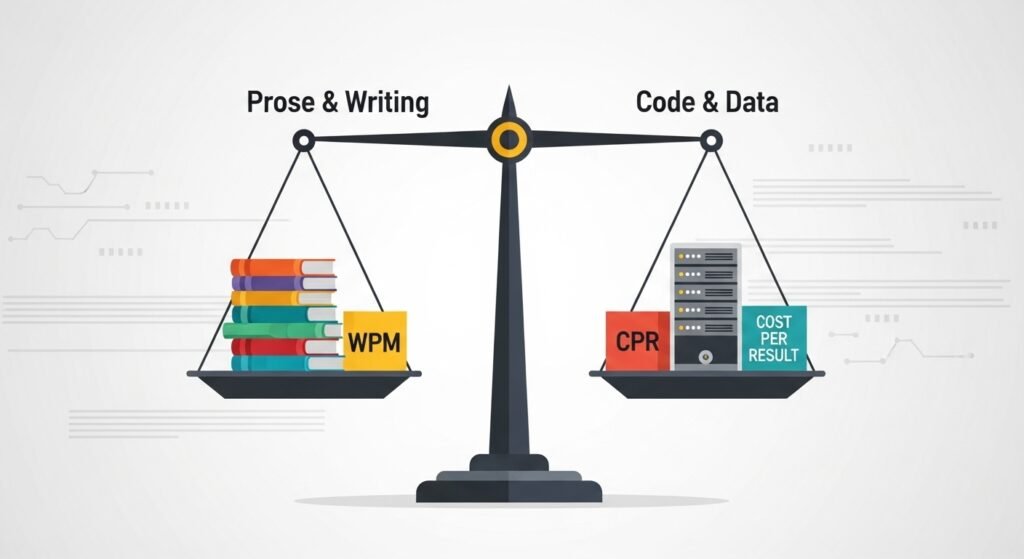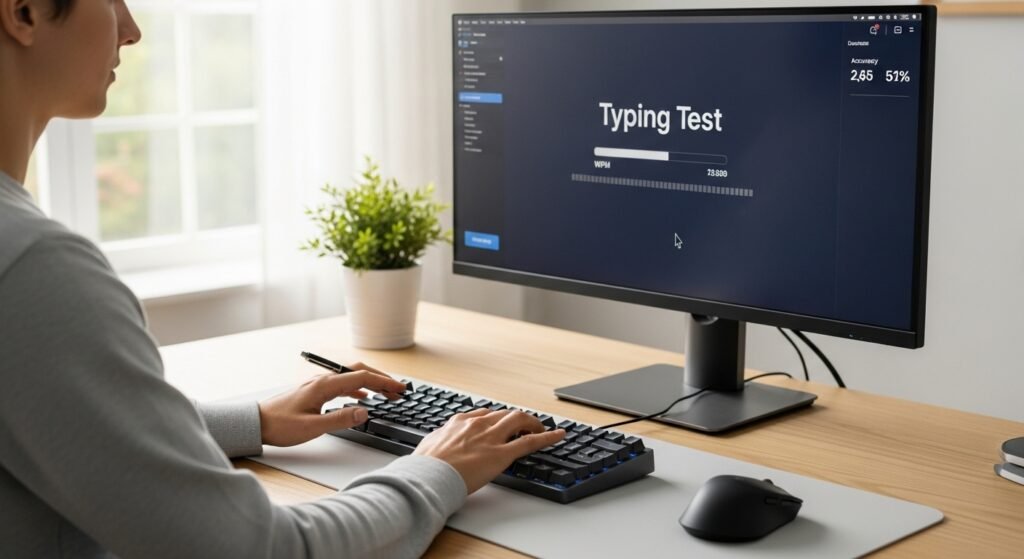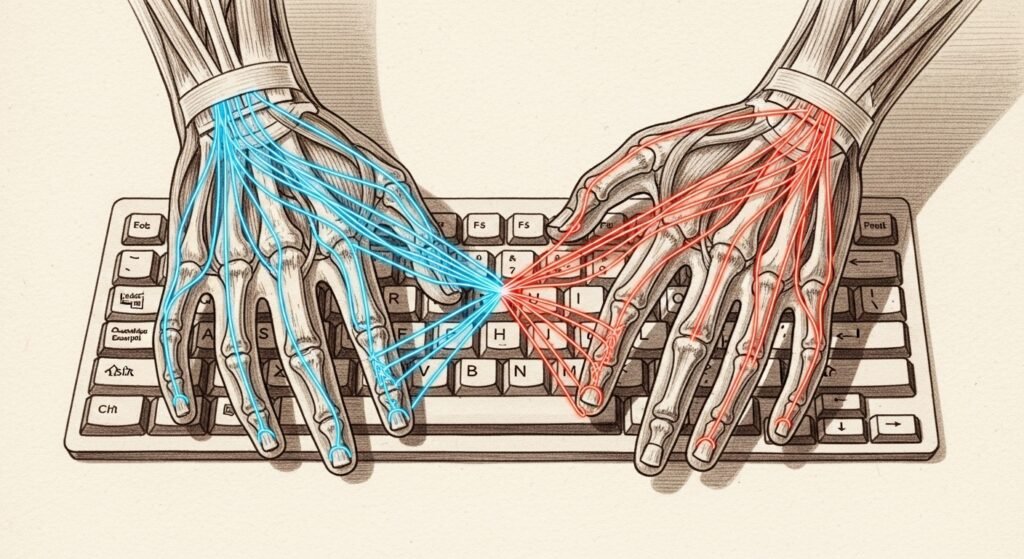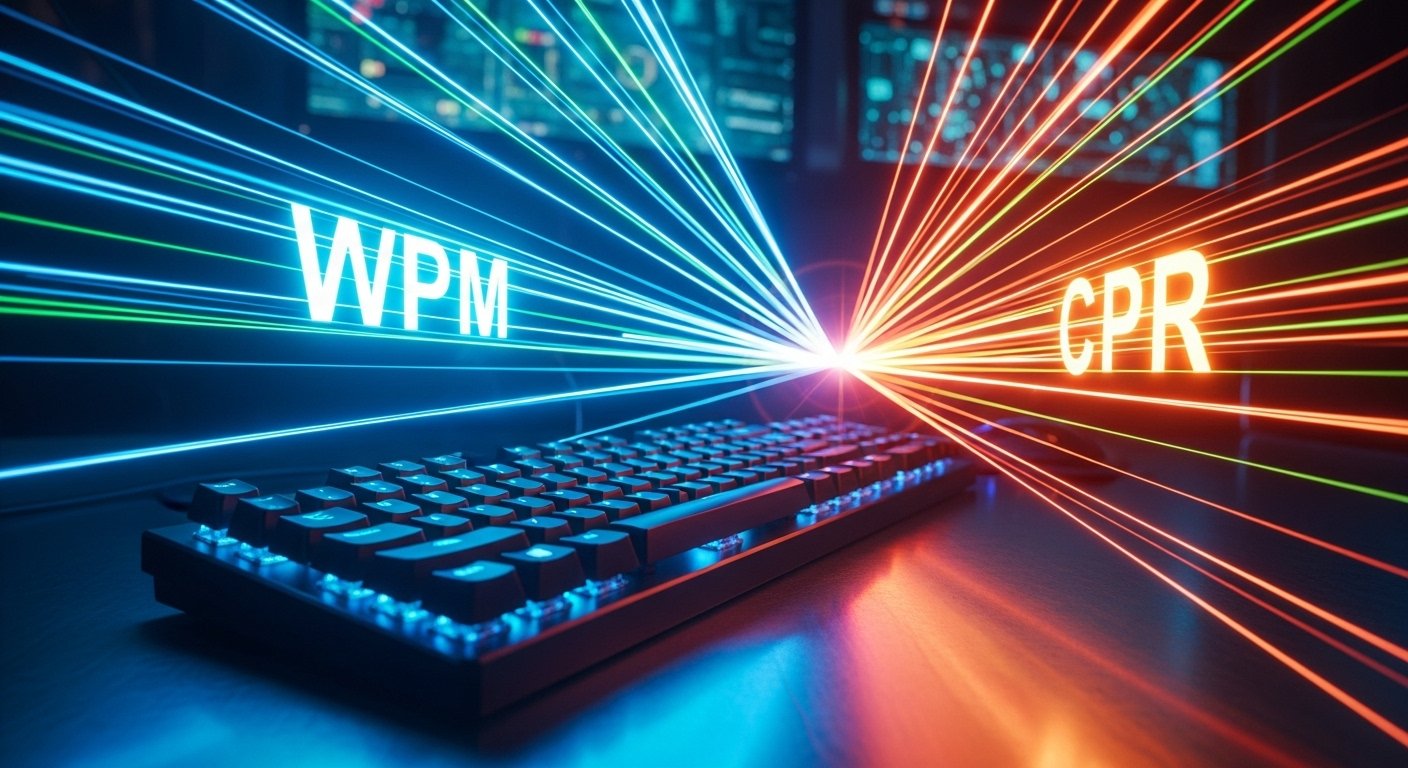You’ve just finished a typing test, and you’re staring at the results. Your Words Per Minute (WPM) score is a solid 75, a number you’re proud of. Yet, you can’t shake the feeling that it doesn’t tell the whole story. When you’re typing complex passwords, lines of code, or entering data into a spreadsheet, the concept of a “word” feels meaningless. You sense there’s another kind of speed—a raw, mechanical quickness—that WPM just doesn’t capture. You’re right. To truly understand your keyboard skills, you need to look beyond the classic metric and explore the critical relationship between Keyboard CPR vs. WPM. This guide will demystify these two essential measures of typing speed, explaining their unique roles and showing you how they work together to give you a complete picture of your proficiency.
This is your definitive guide to becoming a more informed and effective typist. We will break down what WPM (Words Per Minute) truly measures—your rhythm and fluency—and contrast it with CPR (Characters Per Minute), the ultimate metric for your raw, unfiltered finger speed. You’ll learn which metric is more important for your specific tasks, whether you’re a writer, a coder, a gamer, or a data entry professional. More importantly, you’ll learn how to test both accurately to get a true benchmark of your abilities. The best way to start is by seeing these numbers for yourself. A comprehensive Keyboard CPS Test will often give you both scores, providing the perfect starting point for our deep dive. By the end of this guide, you won’t just know your typing speed; you’ll understand it.
The Classic Metric: What is WPM (Words Per Minute)?

Words Per Minute (WPM) is the most traditional and widely recognized measure of typing speed. It’s the metric most of us have been chasing since our first typing class. It is designed to measure your overall typing fluency and pacing when typing standard text, like sentences and paragraphs. Think of it as a measure of your practical, everyday typing proficiency.
The Simple Definition: The “Five-Character Word” Standard
Here’s the secret that many people don’t know: when a test calculates your WPM, it isn’t actually counting the number of real words you type. To create a universal standard, a “word” is defined as five characters, including letters, numbers, punctuation, and spaces.
The formula is simple: (Total Characters Typed / 5) / Time in Minutes = WPM.
So, if you type 400 characters in one minute, your score is 80 WPM (400 / 5 = 80). This standardization is crucial, as it allows for fair comparisons between tests that use different text. Most online tools at sites like CPS-Checker.com perform this calculation for you automatically.
What It Really Measures: Your Rhythm, Fluency, and Overall Pacing
WPM is an excellent measure of your ability to type prose. It rewards a smooth, consistent rhythm and your ability to quickly type common letter combinations and frequently used words. In essence, WPM is a measure of your compositional speed—how quickly you can turn thoughts into coherent sentences. It’s a fantastic benchmark for authors, students, journalists, and anyone who writes emails or reports for a living. It measures your flow, not just your raw finger speed.
A Personal Story: The WPM Score I Chased (and Why It Was Misleading)
For an entire summer, I was obsessed with a single goal: breaking 100 WPM. I practiced relentlessly on typing test websites, memorizing the patterns of common words like “the,” “and,” “about,” and “because.” Finally, one day, I did it. The screen flashed “102 WPM,” and I felt like a typing god.
The illusion shattered the very next day at my job. I had to enter a list of newly generated product IDs, which looked something like this: X7b-!#9-KzP. My fingers, so used to the fluid rhythm of English words, felt clumsy and slow. My real-world speed was a fraction of my celebrated 102 WPM score. That’s when I realized that WPM, for all its glory, had given me a misleading picture of my skills. It measured my fluency with language but completely ignored my raw speed for typing complex, non-word data. It showed me one part of the map but left the other half completely blank.
The Raw Speed Metric: What is CPR (Characters Per Minute)?

If WPM is a measure of your fluency, CPR (Characters Per Minute), often abbreviated as CPM, is the ultimate measure of your raw, unfiltered speed. This metric ignores the concept of “words” entirely and focuses on the most fundamental unit of typing: a single keystroke. It answers a very simple and direct question: how many keys can your fingers physically press in sixty seconds?
The Unfiltered Truth: Counting Every Single Keystroke
Unlike WPM, there is no five-character standard here. The calculation for CPR/CPM is brutally honest and direct. It counts every single character you type—every letter, number, symbol, and spacebar press—and reports that total as your score for the minute.
If you type 400 characters in one minute, your score is 400 CPM. It’s a pure, one-to-one measurement of your mechanical output. This is why it’s such a valuable metric; it’s not influenced by the length of the words or the complexity of the sentences. It’s just speed. This raw input is the same kind of data measured by a Keyboard CPS Test, which breaks the score down into a per-second rate.
What It Really Measures: Your Pure Mechanical Speed and Finger Dexterity
CPR is the perfect benchmark for your transactional speed—how quickly you can execute individual keystrokes, regardless of context. It reveals the true dexterity of your fingers and your ability to move from one key to another with maximum efficiency.
This metric is incredibly important for any task that doesn’t involve typing standard prose. For programmers typing complex syntax, data entry clerks inputting alphanumeric codes, or anyone typing a complex password, CPR is a far more accurate and relevant measure of their true speed than WPM could ever be. It measures your fingers, not your vocabulary.
The Ultimate Analogy: WPM is the Marathon, CPR is the 100-Meter Sprint
This is the easiest way to understand the fundamental difference between the two:
- WPM is a marathon. It’s a test of endurance, pacing, and your ability to maintain a smooth, efficient rhythm over a long distance of familiar terrain (words and sentences).
- CPR is the 100-meter sprint. It’s a test of explosive, raw power. It measures the absolute maximum speed your muscles (in this case, your fingers) can achieve in a short burst, where every single step (or keystroke) counts.
A great marathon runner isn’t always the fastest sprinter, and a world-class sprinter may not have the stamina for a marathon. To be a truly versatile athlete—or typist—you need to train for both.
The Main Event: WPM vs. CPR – Which One Matters More?

Asking whether WPM or CPR is “better” is like asking if a hammer or a screwdriver is the better tool. The answer depends entirely on the job you need to do. They are not competing metrics; they are specialized tools that measure different aspects of your typing skill. Understanding when to use each “tool” is the key to accurately assessing your own abilities and identifying where you have the most room for improvement.
For General Writing and Prose: Why WPM is King
When you are writing an email, an essay, or a story, your task is to translate thoughts into fluent sentences. This is the kingdom of Words Per Minute. WPM excels at measuring your ability to type with a natural rhythm, handling the common patterns and letter combinations of a language with ease. A high WPM score indicates that you can maintain a smooth and consistent pace, which is essential for compositional writing. Think of it like a musician playing a familiar song; the goal is not just to hit the notes quickly but to play them with a fluid, unbroken tempo.
For Data Entry, Coding, and Transcription: Why CPR/CPM is the True Benchmark
Now, imagine your task is to enter this password: 7@k#Z-pQx_v8!. The concept of a “word” is completely useless here. This is where Characters Per Minute reigns supreme. CPR is the true measure of your speed when dealing with:
- Code: Programmers write in complex syntax that mixes letters, numbers, and symbols.
- Data Entry: Clerks input product IDs, serial numbers, and other alphanumeric data.
- Transcription: Transcribers must type exactly what they hear, including stutters and non-word sounds.
In these scenarios, every single keystroke is a distinct, non-rhythmic action. CPR measures your ability to execute these individual actions with maximum speed and precision.
The Critical Role of Accuracy (Net Speed vs. Gross Speed)
A high speed in either metric is worthless if your work is full of errors. This is where the concept of accuracy becomes critical. Most high-quality typing tests will show you two scores:
- Gross Speed: Your raw speed, including all the mistakes you made.
- Net Speed: Your speed after deducting a penalty for errors. This is your true, usable speed.
A fast typist with poor accuracy is not a fast typist at all. The time spent hitting the backspace key to correct mistakes is a massive drain on your overall speed. As many business efficiency studies have shown, the cost of correcting errors often negates any gains from raw speed, a principle well-documented by sources like the Harvard Business Review. Always focus on your Net Speed as the most honest measure of your ability.
How They Work Together: Getting a Complete Picture of Your Skill
The best way to think of these two metrics is as a diagnostic pair.
- WPM is your “cruising speed.” It shows how fast you can comfortably and efficiently travel on a long, straight highway of familiar language.
- CPR is your “0-60 acceleration.” It shows the raw, explosive power of your engine and your ability to execute quick, individual actions.
A high WPM but a low CPR might indicate you are great with language but have slower finger dexterity. A high CPR but a low WPM could mean your fingers are fast, but you struggle with the rhythm and flow of sentence-based typing. By looking at both, you get a complete picture. A comprehensive tool like a Keyboard CPS Test can help you focus on the raw acceleration aspect of your typing skills.
How to Test Both Metrics Accurately

Getting a true measure of your typing skill requires more than just randomly mashing keys on the first website you find. A good test requires the right tool and the right approach. By being deliberate about how you test, you can get a clean, reliable baseline that will give you a true picture of your strengths and weaknesses.
What to Look For in a High-Quality Typing Test Tool
Not all typing tests are created equal. A high-quality tool should provide you with comprehensive data, not just a single WPM score. Here’s what to look for:
- Both WPM and CPR/CPM Scores: This is non-negotiable. The tool must show you both metrics to be useful for our purposes.
- Accuracy Percentage: Your speed is meaningless without accuracy. A good test will prominently display your accuracy and factor it into a “Net Speed” score.
- Different Test Durations: Look for options like 1-minute, 3-minute, and 5-minute tests. This allows you to measure both your sprint speed and your endurance.
- Varied Content: The tool should offer different types of text, including standard prose, punctuation practice, and even random characters to test different aspects of your skill.
A Simple Step-by-Step Guide to Getting Your True Score
To get a result you can trust, follow this simple process:
- Check Your Ergonomics: Sit up straight in your chair with your feet flat on the floor. Your wrists should be in a straight, neutral position, not bent at an awkward angle.
- Do a Quick Warm-Up: Type for a minute or two without a timer just to get your fingers loose. You can use an online keyboard keys test to ensure all your keys are responding correctly before you begin.
- Choose the Right Test: Select a 1-minute test using standard English text. This is the gold standard for getting a reliable baseline score.
- Focus on Accuracy, Not Speed: During the test, your primary goal should be to type accurately. Don’t try to force your speed. A smooth, accurate pace will always result in a higher Net Speed than a frantic, error-filled sprint.
- Take the Test Three Times: Take the test three times and average your Net WPM and Net CPR scores. This helps account for any single-test jitters and gives you a much more stable and realistic benchmark. A great place to perform this is on a comprehensive Keyboard CPS Test that provides detailed feedback.
Case Study: Analyzing My Own Test Results (WPM vs. CPM)
After taking a 1-minute test, here are my (hypothetical) results:
- Net WPM: 85
- Net CPM: 425
What does this tell me? First, I can see the five-character rule in action: 425 characters divided by 5 equals exactly 85 words. This confirms the test uses the industry standard. More importantly, it shows that my raw speed (425 CPM) perfectly aligns with my prose-typing fluency (85 WPM). This indicates a balanced typing style where my finger dexterity is not a bottleneck when typing standard text. If my CPM were significantly higher (say, 500+), it would suggest my fingers are faster than my ability to process and type words, meaning I could improve my WPM by focusing on rhythm and flow. If my CPM were lower, it would mean I need to work on my raw finger speed with dexterity drills.
Beyond the Numbers: A Simple Plan to Improve Both Speeds

Getting your scores on a typing test is the easy part. The real journey begins when you decide to make those numbers climb. Improving your typing speed isn’t about secret tricks or magic software; it’s about consistent, focused practice on the right things. This simple plan will give you the foundational skills and targeted drills you need to boost both your WPM and your CPR.
The Foundation of All Speed: The Magic of Touch Typing
If you are still looking down at your keyboard while you type (a method known as “hunt and peck”), you have a hard ceiling on your potential speed. The single most important thing you can do to become a faster typist is to learn touch typing.
This is the method of typing without looking at the keyboard, using muscle memory to know where all the keys are. Your fingers rest on a “home row” (ASDF for the left hand, JKL; for the right), allowing you to reach any key with minimal movement. Learning this skill is a game-changer. It might feel slower at first, but once it clicks, your speed in both WPM and CPR will skyrocket because you’re no longer dividing your attention between the screen and your hands.
Drills for WPM: Focusing on Flow and Common Word Patterns
To improve your WPM, you need to train your brain and fingers to handle the natural rhythm of language.
- Practice with Real Sentences: Instead of just typing random words, practice on full paragraphs and articles. This builds your muscle memory for common letter combinations (“the,” “ing,” “tion”) and the flow of punctuation.
- Focus on Consistency: Use a typing test and watch the graph. Your goal isn’t just a high peak speed, but a smooth, flat line. Try to maintain a consistent pace that you can hold without making errors. This builds the stamina needed for a high WPM score.
Drills for CPR: Improving Finger Dexterity and Raw Keystroke Speed
To improve your CPR, you need to train your fingers for raw, mechanical speed, separate from language.
- Practice with Non-Word Text: Use a typing test that offers practice with random characters, numbers, and symbols. This forces your fingers to move to less common keys and breaks your reliance on familiar word patterns.
- Run Finger Drills: Open a blank document and practice simple patterns as fast as you can, like “asdfg hjkl;” or “aqswde frgt hyju iklo;”. This is like a pianist practicing scales. It builds the fundamental dexterity and speed in your fingers. A tool like a Keyboard CPS Test is excellent for this, as it measures your raw keystroke speed without caring about words at all.
2: Frequently Asked Questions (FAQ)
You’ve learned the definitions, the applications, and how to train. But a few specific questions often come up when diving into the world of typing metrics. Here are the direct answers.
What is a “good” WPM score vs. a “good” CPR/CPM score?
WPM: An average typist is around 40 WPM. A proficient or professional typist is typically between 65 and 85 WPM. Anything over 100 WPM is considered very fast.
CPR/CPM: Since a “word” is standardized as five characters, your CPM will typically be about 5 times your WPM. So, an average CPR is around 200 (40 WPM x 5), and a proficient CPR is in the 325-425 range.
Is one score always higher than the other?
What is the difference between CPM and KPM (Keystrokes Per Minute)?
Why do some tests use a different standard word length?
Conclusion
You now have a complete, 360-degree view of your typing abilities. The confusion is gone. You understand that the numbers on your screen tell a story with two distinct but equally important characters. In the matchup of Keyboard CPR vs. WPM, there is no single winner, only a partnership. WPM is your fluent storyteller, the measure of your ability to compose with rhythm and flow. CPR is your raw athlete, the pure, unfiltered measure of your finger dexterity and mechanical speed. A true typing master doesn’t just chase one number; they understand the value of both.
Remember that initial feeling of confusion, staring at a WPM score that felt incomplete? That’s a thing of the past. You are now empowered with the knowledge to read the full story of your skills, to diagnose your weaknesses, and to train with purpose. You know when to focus on your marathon pace and when to work on your hundred-meter sprint. Your journey to becoming a faster, more efficient typist starts with a single, informed look at your own performance. So, we challenge you to take a typing test right now, but this time, look at both numbers.
Based on what you do most, which metric are you more excited to start improving?

Hello, I’m John Harbour, a software developer passionate about creating innovative and accessible AI tools. As the creator of cps-checker.com, I enjoy building useful software and writing blogs to help people get the most out of my creations.

